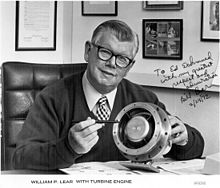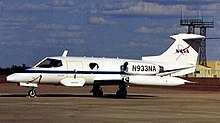William Lear
William "Bill" Powell Lear (born June 26, 1902 in Hannibal, Missouri , † May 14, 1978 in Reno, Nevada ) was an American inventor and entrepreneur .
Life
Lear grew up in Chicago , where he dropped out of school after eighth grade and went to the United States Navy . During the First World War he was a radio operator in the military. In the late 1920s, he and Elmer Wavering invented the first workable car radio . A short time later he developed devices for aviation technology , such as radio beacon direction finders ( LearAvian ) and the first autopilot .
In 1941 he married Moya Marie Olsen, a daughter of vaudeville comedian Ole Olson . The Lear couple have four children: John , Shanda, David and Tina.

In 1949 he founded Lear, Incorporated in Santa Monica . Among other things, he developed business jets as conversions of the Lockheed Model 18 Lodestar , which he successfully marketed under the name Learstar . He developed the ideas for a twin-engine business travel jet, which he wanted to realize in Europe for cost reasons. In 1960 he moved to Switzerland because of this . After a fruitful collaboration with Hans-Luzius Studer from FFA AG , in which the construction of the new jet under the designation SAAC-23 could essentially be completed, he moved back to the USA ( Wichita (Kansas) ) in 1962 because it had become clear to him that the sales market for the machine was mainly in the USA. In Wichita, he founded Lear Jet Industries . On October 7, 1963, the first test flight of the Learjet 23 aircraft type took place, which later went into series production.
In 1964 he invented the 8-track cassette .
The successful Canadair Regional Jet flight type is based on the LearStar 600 type. The Canadair aircraft yard bought the license and converted the model to the Canadair CL-600 Challenger Jet. Learjet was acquired by Bombardier Aerospace in 1990 .
His last major success was the LearFan flight type , a turboprop aircraft made of composite material instead of the previously common aluminum . Another special feature was the pusher concept: a propeller attached to the rear is driven by two motors.
Web links
- MIT Inventor of the Week (English)
- Biography from The National Aviation Hall of Fame (English)
- LearFan . at AviationExplorer.com (English)
bibliography
- Boesen, Victor: They Said It Couldn't Be Done: The Incredible Story of Bill Lear . Doubleday, 1971, ISBN 0-385-01841-X .
- Rashke, Richard: Stormy genius: the life of aviation's maverick, Bill Lear . Houghton Mifflin Co., Boston 1985, DDC: 629.1300924, LCC: TL540, ISBN 0-395-35372-6 .
| personal data | |
|---|---|
| SURNAME | Lear, William |
| ALTERNATIVE NAMES | Lear, William Powell (full name); Lear, Bill |
| BRIEF DESCRIPTION | American inventor and entrepreneur |
| DATE OF BIRTH | June 26, 1902 |
| PLACE OF BIRTH | Hannibal (Missouri) , USA |
| DATE OF DEATH | May 14, 1978 |
| Place of death | Reno (Nevada) |

